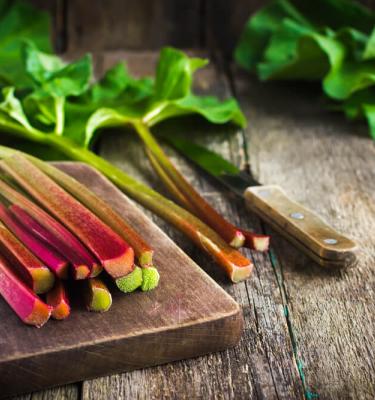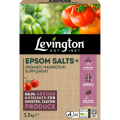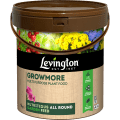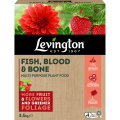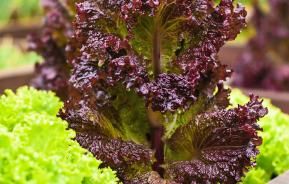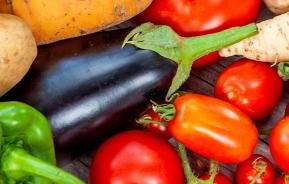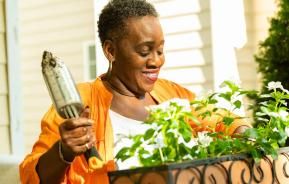You simply can’t beat a delicious rhubarb crumble made with your very own sweet, tart rhubarb stems.
Rhubarb (Rheum x hybridum) is a hardy perennial that keeps on coming back for years, giving you a fresh harvest of juicy stems every spring. Here’s our simple guide to growing rhubarb.
Equipment list for growing rhubarb
To grow delicious rhubarb, you will need:
- Rhubarb crowns.
- A spade.
- A supply of compost or well-rotted farmyard manure such as Miracle-Gro Premium All Purpose Compost.
- A balanced garden fertiliser.
Rhubarb varieties

There are many different varieties of rhubarb available, but some stand out from the crowd. Here are a few of our favourite types of rhubarb:
- Rhubarb ‘Hawkes Champagne’ AGM: a compact, high-yielding variety, producing bright red stems with a sweet taste.
- Rhubarb ‘Timperley Early’ AGM: bred especially for indoor forcing, this variety also grows well unforced, producing an early harvest of pink stems streaked with green.
- Rhubarb ‘Victoria’: one of the oldest varieties but still popular, producing a heavy crop of pink-tinged green stems with a good balance of sweetness and acidity.
- Rhubarb ‘Glaskin’s Perpetual’: a late-cropping variety producing large, juicy pink- and green-streaked stems with a sweet flavour.
Where to grow rhubarb
A sunny site is best for growing rhubarb, although it can cope with some shade. Rhubarb needs a soil that is both fertile and free-draining, as the crowns will rot if left to sit in cold, wet soil. To improve the soil’s structure and fertility, dig in lots of compost or well-rotted farmyard manure a few weeks before planting.
How to grow rhubarb
Rhubarb is usually grown from crowns. These are young plants, between one to two years old, that look like bundles of tuberous roots, topped by a few buds.
The best time to plant rhubarb is in late autumn or early winter when the plant is dormant, although it can also be planted in early spring. Make sure you do the following:
- Clear the area of all weeds and stones.
- Plant the rhubarb crowns 1m (3ft) apart with 1.2m (4ft) between rows.
- Plant the crowns with their buds just below the surface of the soil.
Caring for rhubarb
Once established, rhubarb will largely take care of itself, but for the best harvest, follow these tips:
- In spring, cover the plants with fleece to protect the new stems from sudden cold snaps. If the stems are caught by frost, they are likely to blacken and wilt, but the plants themselves will survive and produce more stems.
- Feed the plants with a balanced fertiliser in spring./li>
- Water regularly in dry spells.
- Deadhead any flowers as soon as they appear, to focus all the plants’ energy into producing stems and leaves.
- Once the foliage has died back in autumn, cut off all old leaves and compost them. Provided the soil is well-drained, the plants will not be harmed by cold winter weather. In fact, the crowns need a period of temperatures below 3ºC (37ºF) to stimulate new growth in spring.
- Mulch around the plants in autumn with a thick layer of organic compost or well-rotted farmyard manure. Take care not to bury the crowns when mulching, or they may rot.
- Rhubarb plants need to be divided every five to six years to rejuvenate them. In winter, when the plants are dormant, dig up any crowns that need to be divided. Using the sharp edge of a spade, cut the crowns into three or four separate segments, making sure each segment has at least one bud. Replant each segment as a new plant.
Forcing rhubarb
Forcing rhubarb is a technique used by gardeners for many years as a way of getting an early rhubarb harvest. Discovered by accident at the Chelsea Physic Gardens in the early 19th century, the forcing process simply involves excluding all light from the plants. This stimulates them to grow, producing pale, tender stems with a delicate flavour that can be harvested around two to three weeks before the normal crop.
In mid to late winter, select the crowns you wish to force and cover them with straw, then place large containers over these crowns to block out all light. You can buy purpose-made rhubarb forcing pots, but an upturned bucket or dustbin works equally well. When the stems reach the tip of the container, they are ready to harvest.
Forcing rhubarb weakens the plant, so only force established plants, and don’t force the same plant two years running.
Rhubarb problems to look out for
Rhubarb is generally trouble-free, but in wet soil it can suffer from crown rot. This causes the crowns to turn brown and soften, and the rot may spread to stems and leaves. Dig up all affected plants as soon as possible and destroy them.
Harvesting rhubarb
Harvesting rhubarb does require a little patience, but the results are well worth it. To give new plants a chance to establish themselves well, don’t harvest any rhubarb at all in the first year after planting. In the second year, you can harvest a few stems from each plant, but make sure to leave at least three or four strong stems on the plant.
In the following years, you can harvest up to half of the stems on each plant.
Harvest from mid-spring when the stems have a good colour and the leaves are fully unfurled. Don’t cut the stems to harvest them, just hold them at the base and pull firmly to detach them from the crown.
Stop harvesting rhubarb after mid-June to give the plants a chance to build up their reserves again for next year’s crop.
Note: Never eat rhubarb leaves, as they are toxic. Cut them off the harvested stems and either throw them away or compost them.
Plant rhubarb in your garden this autumn and you’ll be enjoying delicious tarts and crumbles for years to come!

